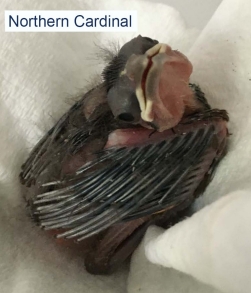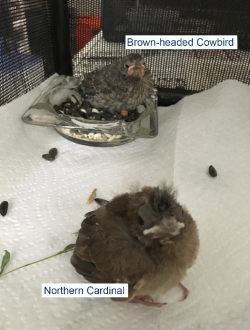Northern Cardinal
Cardinalis cardinalis"Redbird" is a popular common name for the Northern Cardinal. This non-migratory bird is abundant in Tennessee and can be found in a variety of habitats from suburban neighborhoods and rural areas, to bottomland forests and mountainsides. A cardinal will often spend its entire life within a mile of where it hatched.
The range of the Northern Cardinal extends throughout eastern and central North America from southern Canada into parts of Mexico and Central America. That range has expanded northward since the early 1800s, likely because of milder winter temperatures, increased nesting habitat, and the presence of bird feeders.
Description: The male and female look very different, but both have a prominent crest and a red cone-shaped bill.
The male is a brilliant crimson red with a black facemask; the female is mostly grayish-brown with reddish wings, crest, and tail. Her facemask is gray to black and is less defined than that of the male.
Juvenile birds (April-September) look like the adult female but are duller and have a black bill that gets more orange through the fall.
Length: 8.75"
Wingspan: 12"
Weight: 1.6 oz
Voice: The song is a series of clear repeated, usually 2-note phrases, purdy purdy purdy or whoit cheer whoit cheer. The call is similar to two coins hitting each other.
Similar Species:
- This species cannot be easily confused with any other species found in Tennessee, although the only other all red songbird in the state is the Summer Tanager.
Habitat: Northern Cardinals can be found in a variety of habitats but require open patches of ground for feeding, trees for singing perches, and dense, low growth for nesting. Habitats include woodland with thick understory, forest edges, swamps, streamside thickets, hedgerows, and shrubbery around homes and parks.
Diet: Seeds, fruits, buds, and insects. Frequently visits bird feeders.
Nesting and reproduction: In late February and March, males and females start defending their territory with song, displays, and mild combat. Male cardinals can be so aggressive that they may defend their territory from their own reflection in a window or a mirror! Nest building usually begins in April and cardinals usually raise at least two broods in a year.
Clutch Size: Usually 3 eggs, with a range of 1 to 5 eggs.
Incubation: The female incubates the eggs for 12 to 13 days.
Fledging: Both the male and female care for the nestlings, which leave the nest in 9 to 11 days.
Nest: The female chooses the nest site and builds the nest with occasional help from the male. The nest is an open bowl of weed stems and twigs, and lined with grass. It often contains paper or plastic in the outer layer. The nest is placed in a thick tangle of vines or twigs in a shrub or small tree, and the average nest height in Tennessee is 5 feet, with a range from 1 foot to 12 feet.
Status in Tennessee: The Northern Cardinal is an abundant permanent statewide resident. The population is currently stable or slightly declining.
Dynamic map of Northern Cardinal eBird observations in Tennessee
Fun Facts:
- Unlike most northern songbirds, both males and females sing. When the female sings from the nest it appears that she is providing the male with information about whether to bring food to the nest. A mated pair shares song phrases, but the female may sing a longer and slightly more complex song than the male.
- The population density and range of the Northern Cardinal has increased over the last 200 years, largely in response to habitat changes made by people.
- The male cardinal fiercely defends its breeding territory from other male cardinals. When a male sees its reflection in glass surfaces (i.e. windows and mirrors), it frequently will spend many hours daily trying to fight the imaginary intruder. This may go on for the entire breeding season. One remedy is to tape paper on the outside of the offending window until he looses interest.
- Not all male cardinals look the same. Brighter red males hold territories that have denser vegetation, feed young at higher rates, and have greater reproductive success than duller males.
- The oldest known wild Northern Cardinal was 15 years 9 months old.
Obsolete English Names: redbird, common cardinal, eastern cardinal, cardinal grosbeak, cardinal redbird
Best places to see in Tennessee: The Northern Cardinal is an abundant year round resident across the state.


